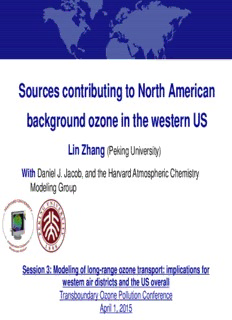
Zhang et al., ACP 2014 PDF
Preview Zhang et al., ACP 2014
Sources contributing to North American background ozone in the western US Lin Zhang (Peking University) With Daniel J. Jacob, and the Harvard Atmospheric Chemistry Modeling Group Session 3: Modeling of long-range ozone transport: implications for western air districts and the US overall Transboundary Ozone Pollution Conference April 1, 2015 2 Long-range transport of ozone pollution to the western US Springtime ozone profile at Trinidad Head, CA Stratosphere Lightning Transport of anthropogenic pollution Wildfires Local human activities Black: measurements (baseline) Green: model results Red: North American background (~5 ppbv lower than model) (McDonald-Buller et al., AE 2011) Annual 4th highest North American background ozone for 2006-2008 3 TES and AIRS observations of a transpacific plume TES GEOS-Chem AIRS CO columns A B A B 2006 (Zhang et al., ACP 2008) Ozone production in transpacific plumes Mean for the INTEX-B period (April 17-May 15, 2006) Enhanced gross ozone production from Asian emissions at 800 hPa Differences of gross ozone production rates from the standard simulation and a sensitivity simulation L Sea level pressure and 800 hPa winds overplotted H Direct transport of Asian ozone produced in the boundary layer and continuous ozone formation over the Pacific (decomposition of PAN) Splitting of transpacific plumes over the northeast Pacific (Zhang et al., ACP 2008) Impact of rising Asian emissions on surface ozone Data from Dan Jaffe (Univ. of Washington) 2006 surface Asian O enhancements 3 O measurements at Mt. Bachelor 3 (44oN, 122oW, 2.7 km, in central Oregon) 54 ± 10 53 ± 8 9.4 ± 2.5 O increase from 2000 to 2006 3 Asian emissions increase surface ozone in the western US by 5-8 ppbv. Doubling Asian emissions from 2000 to 2006 increases surface ozone by 1- 2 ppbv in the west US. (Zhang et al., ACP 2008) Multiple model estimates of intercontinental ozone influences Receptor = NA 21 chemical transport models reported to TF HTAP (Task Force on Hemispheric Transport of Air Pollution) ±50% ranges among the models Receptor = EU Receptor = EA (Fiore et al., JGR 2009) GEOS-Chem ozone simulation at the western CASTNet sites GEOS-Chem with the GEOS-5 native 1/2o x 2/3o resolution over North America and adjacent oceans (140o-40oW, 10o-70oN), and 2ox2.5o resolution over rest of world. Daily 8-h max ozone time series in spring - summer 2006 CASTNet ozone Numbers inset are the means and annual 4th highest values (in parentheses) monitoring sites (cid:9) NA anthro. 10-22 ppbv 11-16 ppbv Intercontinental transport plus anthro. CH 4 (cid:9) 8 (Zhang et al. AE 2011) GEOS-Chem simulated vs. observed ozone exceedances at the western sites Has some success at individual sites but fails to capture the exceedances for the 65 and 70 ppbv thresholds in spring. 9 (Zhang et al. AE 2011) Influences of lightning NO emissions on surface ozone x Lightning NO emissions constrained by NLDN x (cid:9) Simulated ozone enhancements from lightning emissions for summer 2007 Measurements GEOS-Chem (Zhang 2011) GEOS-Chem (Zhang 2014) Δ lightning (cid:9) Using the NLDN data largely corrects ozone overestimates over the Southwest US in summer. 6-8 ppbv ozone on average from lightning with moderate variability. (Zhang et al., ACP 2014)
Description: